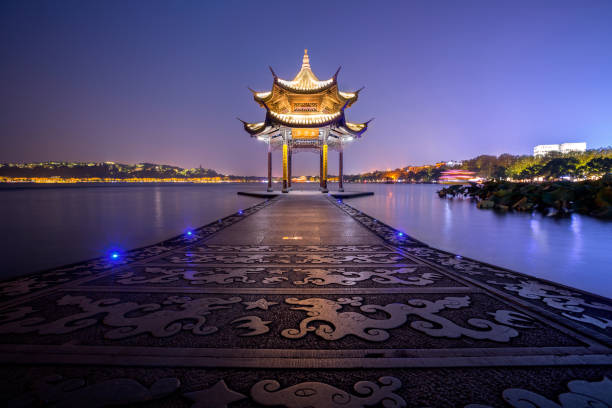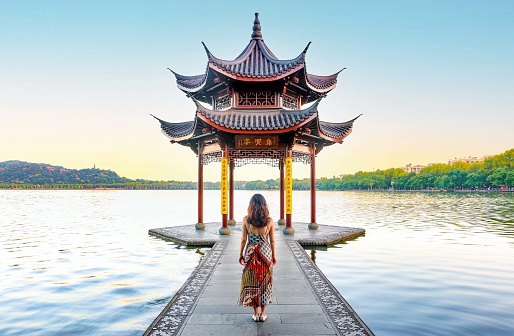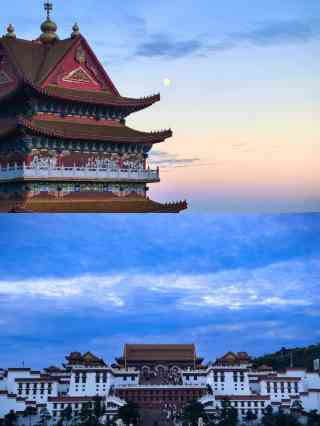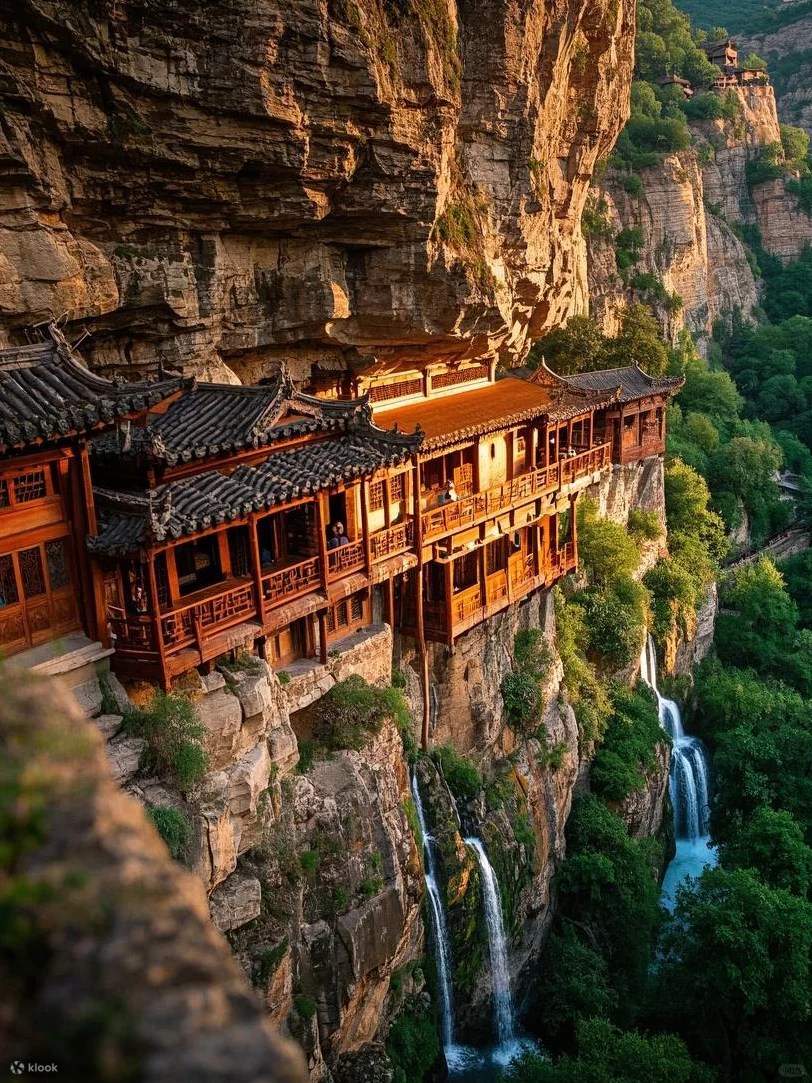Exploring Fengguo Temple, Yixian: A Must-Visit for Culture Enthusiasts

An Essential Guide to Visiting Fengguo_Temple_Yixian
Nestled in the heart of Yixian County, Liaoning, Fengguo Temple stands as an enduring testament to China’s rich cultural heritage and architectural prowess. Dating back to 1020 AD, this remarkable structure is one of the last remaining monuments of the Liao Dynasty, captivating visitors with its stunning craftsmanship and spiritual significance. As you approach the temple, you are greeted by an air of tranquility that seems to echo the whispers of centuries past, inviting you to explore its hallowed halls.
Fengguo Temple is not just a historical site; it is a sanctuary for those seeking a deeper connection to Buddhism and a glimpse into the artistic brilliance of the past. The temple’s Great Buddha Hall, with its awe-inspiring wooden architecture and the world’s oldest colored clay Buddha statues, creates a breathtaking backdrop for reflection and reverence. Many visitors find themselves entranced by the intricate murals and the serene presence of the Seven Buddhas, which dominate the hall and embody the spiritual legacy of the Liao Dynasty.
Whether you are an architecture enthusiast, a history buff, or simply a traveler seeking unique experiences, visiting Fengguo Temple promises to be a highlight of your journey. With its rich tapestry of stories, stunning artistry, and tranquil ambiance, this ancient temple invites you to step back in time and immerse yourself in the profound beauty of China’s spiritual heritage. Prepare to be enchanted by the sights, sounds, and stories that await you within these sacred walls.
In This Guide
- An Essential Guide to Visiting Fengguo_Temple_Yixian
- The Rich History and Legends of Fengguo_Temple_Yixian
- Main Highlights: What You Absolutely Can’t Miss
- Planning Your Visit: A Practical Guide
- Tickets: Prices, Booking, and Tips
- How to Get There: A Complete Transportation Guide
- Local Cuisine and Accommodation Nearby
- Frequently Asked Questions
- Final Thoughts on Your Trip
The Rich History and Legends of Fengguo_Temple_Yixian
Nestled in the serene landscape of Yi County, Jinzhou, Fengguo Temple stands as a testament to the rich cultural and architectural heritage of China, particularly from the Liao Dynasty. Established in 1020 AD during the reign of the Liao Dynasty, this magnificent temple has persevered through the sands of time, surviving wars, earthquakes, and even a World War II artillery shell that pierced its roof without detonation. Its resilience and beauty have earned it the designation of a national key cultural relic, revered for its historical significance and architectural prowess.
Fengguo Temple is one of only three remaining major temples from the Liao Dynasty, a period marked by significant cultural development and the flourishing of Buddhist architecture. The temple embodies a remarkable blend of spirituality and artistry, featuring the Great Buddha Hall, which is celebrated as the largest single-eave wooden structure from ancient China. This architectural marvel measures an impressive 55 meters in width and 24 meters in height, supported by a minimal number of wooden pillars, showcasing the extraordinary ingenuity of 11th-century construction techniques. Renowned architect Liang Sicheng hailed the hall as a “millennium-old national treasure,” underscoring its architectural significance.
As you step into the Great Buddha Hall, you are greeted by the sight of the Seven Buddhas, the oldest colored clay statues in the world, each towering over eight meters tall. These figures represent Sakyamuni and the six previous Buddhas, intricately crafted to inspire reverence and reflection among visitors. The hall is adorned with exquisite murals depicting flying apsaras, celestial beings of Liao artistry, painted with vibrant colors that have stood the test of time. The interplay of light filtering through the wooden beams creates a serene atmosphere, inviting contemplation and appreciation of the temple’s spiritual aura.
Beyond its architectural grandeur, Fengguo Temple is steeped in legends that speak to its significance in Chinese culture. It has been a site of pilgrimage and devotion, attracting worshippers who seek solace and enlightenment within its hallowed halls. The temple has also gained fame as a filming location for notable movies, including Wong Kar-wai’s The Grandmaster, which featured stunning scenes that showcased the temple’s historic ambiance and artistic beauty.
Visitors to Fengguo Temple not only immerse themselves in the rich tapestry of history but also experience the harmonious blend of Buddhist and Taoist cultures that have thrived in the region for centuries. This temple, with its profound legacy and captivating legends, offers an enriching glimpse into the spiritual heart of the Liao Dynasty and the enduring legacy of Chinese Buddhism. As you wander through its sacred grounds, you are not merely observing history; you are walking through the echoes of a civilization that has shaped the spiritual landscape of China for over a millennium.

Fengguo_Temple_Yixian.
Main Highlights: What You Absolutely Can’t Miss
Fengguo Temple, steeped in millennia of history, is a marvel that beckons travelers to immerse themselves in its beauty and significance. Here are the must-see highlights that you absolutely cannot miss during your visit to this iconic site:
Great Buddha Hall
Step into the Great Buddha Hall, the temple’s architectural crown jewel, which boasts the largest single-eave wooden structure in ancient China. Spanning an impressive 55 meters in width and 24 meters in height, this hall showcases the ingenious “column-reduction technique” that was revolutionary in the 11th century. Marvel at the intricate wooden beams adorned with painted flying apsaras and gaze upon the Seven-Buddha statues—each towering over eight meters. This collection is unique, representing Sakyamuni alongside six past Buddhas, and is the oldest of its kind in the world.
Colorful Sculptures and Murals
Don’t miss the exquisite colored sculptures housed within the hall. The vibrant artistry of the Yuan Dynasty murals enchants visitors, while the detailed carvings and rich colors create a feast for the eyes. Pay special attention to the reverse-seated Guanyin, a striking figure that adds to the hall’s spiritual ambiance.
Historical Significance
Fengguo Temple is not just a site of stunning artistry; it is a national treasure recognized for its cultural and historical importance. Built in 1020 during the Liao Dynasty, the temple has withstood the test of time, surviving natural disasters and conflicts. Renowned architect Liang Sicheng called it a “millennium-old national treasure,” and its preservation is a testament to the rich Buddhist heritage of the region.
Filming Location
Film enthusiasts will appreciate that Fengguo Temple served as a shooting location for Wong Kar-wai’s acclaimed film, The Grandmaster, featuring Zhang Ziyi. The interplay of light and shadow across the ancient architecture creates a cinematic backdrop that captivates photographers and movie buffs alike.
Qing Dynasty Complex
Venture beyond the Great Buddha Hall to explore the Qing Dynasty Complex. Here, you will find stone lions at the gate, intricately carved wooden archways, and stele pavilions that reflect the craftsmanship of the era. This area provides a serene environment for contemplation and appreciation of the temple’s extensive history.
Archaeological Site
For history buffs, the archaeological site surrounding the temple reveals remnants of Liao Dynasty corridors and pavilions. Ongoing excavations allow visitors to glimpse the ancient infrastructure and gain insights into the architectural practices of the time.
Scenic Surroundings
Finally, take a moment to enjoy the natural scenery surrounding Fengguo Temple. The quiet charm of Yi County offers a picturesque backdrop, ideal for a reflective stroll or capturing memorable photographs. Look out for playful temple squirrels—bring some nuts to make a new furry friend!
Practical Tips
- Visiting Hours: Open from 8:00 AM to 4:30 PM in peak season (April to October) and 8:30 AM to 4:00 PM in the off-season (November to March).
- Admission Fee: Approximately 50 RMB, with parking available for a small fee.
- Recommended Duration: Allow 1-2 hours to fully appreciate the temple’s highlights.
In essence, a visit to Fengguo Temple is a pilgrimage into a rich tapestry of history, art, and spirituality. Each corner reveals stories of a bygone era, making it an unforgettable stop on your journey through Liaoning.

Fengguo_Temple_Yixian.
Planning Your Visit: A Practical Guide
Planning Your Visit to Fengguo Temple, Yixian
Fengguo Temple is not just a historical site; it’s a journey into the heart of China’s Liao Dynasty, showcasing stunning architecture and spiritual heritage. To make the most of your visit, here’s a practical guide to help you prepare for this unique experience.
Getting There
By Air:
The nearest airport is Jinzhou Bay Airport. From there, you can take a taxi or a bus to reach Yixian County.
By Train:
Opt for a high-speed train to Jinzhou Station, which is more convenient. From Jinzhou, local buses or taxis will take you to Yixian, approximately 40 minutes away.
By Car:
If you prefer to drive, head to “Fengguo Temple Parking Lot,” which is well-signposted. The ride from Jinzhou to the temple takes around 1.5 hours.
Admission Details
- Ticket Price: 50 RMB (approximately)
- Parking Fee: 10 RMB per visit
- Opening Hours:
- Peak Season (April 1 – October 31): 8:00 AM – 4:30 PM (last entry at 4:00 PM)
- Off-Season (November 1 – March 31): 8:30 AM – 4:00 PM (last entry at 3:30 PM)
What to Expect
Time Required: Allocate about 1-2 hours for your visit to fully appreciate the temple’s architectural marvels and historical significance.
Must-See Highlights:
– Great Buddha Hall: Marvel at the seven towering clay Buddha statues, each over 8 meters tall, and the intricate flying apsaras painted on the beams.
– Qing Dynasty Complex: Explore the stone lions, wooden archway carvings, and stele pavilion engravings.
– Archaeological Site: Witness ongoing excavations of the Liao Dynasty’s structures.
What to Bring
- Documents: Bring your ID card and any relevant student or senior citizen discounts.
- Clothing: Dress according to the season—light clothing and sun protection for summer; warm layers for winter.
- Essentials: Don’t forget your phone, camera, charger, a power bank, and any personal medications.
Local Transportation
Once in Yixian, transportation options are easy to navigate:
– Taxis: Local taxis are affordable; however, it’s advisable to book in advance.
– E-bikes: Shared e-bikes are available for around ¥3/hour, providing a fun way to explore the area.
Nearby Attractions
After visiting Fengguo Temple, consider exploring the following nearby sites:
– Guangsheng Pagoda: A millennium-old Liao tower showcasing exquisite brick carvings.
– Liaoshen Campaign Memorial Hall: A patriotic education base with significant historical artifacts.
– Bijia Mountain: Offers stunning views and is home to historical sites like Lüzu Pavilion.
Culinary Delights
Don’t miss the chance to savor local flavors:
– Jinzhou BBQ: Try skewers of lamb, beef, and pigeon, expertly grilled.
– Steamed Pancake (Húbǐng): A local specialty from Rongpeng, featuring chewy pancakes filled with tender stewed beans.
– Seafood: Fresh local catches, including steamed fish and garlic scallops, are a must-try.
Accommodation Options
For a comfortable stay in Yixian:
– Central Avenue Area: Look for hotels like Jinzhou Golden Tulip or Atour, which offer easy access to dining and shopping.
– Bijia Mountain: Choose seaside B&Bs or hotels for beautiful ocean views and beach access.
Pro Tips
- Best Time for Photos: Early morning or an hour before closing offers the perfect lighting for stunning photographs.
- Squirrels at the Temple: Bring some nuts to feed the friendly squirrels on-site!
- Cultural Etiquette: Be respectful during your visit, as Fengguo Temple is a functioning religious site.
Conclusion
Visiting Fengguo Temple is more than just a sightseeing trip; it’s an immersion into a rich historical narrative and a celebration of ancient artistry. With this guide, you’ll be well-prepared to explore one of China’s greatest treasures. Enjoy your journey through time!

Fengguo_Temple_Yixian.
Tickets: Prices, Booking, and Tips
When planning your visit to Fengguo Temple in Yixian, it’s essential to know the ticket prices, booking options, and insider tips to enhance your experience.
Ticket Information
- General Admission: 50 RMB (approximately 7 USD)
- Parking Fee: 10 RMB per visit
Operating Hours
- Peak Season (April 1 – October 31):
- Open from 8:00 AM to 4:30 PM (last entry at 4:00 PM)
- Off-Season (November 1 – March 31):
- Open from 8:30 AM to 4:00 PM (last entry at 3:30 PM)
Booking Tips
- Advance Purchase: While tickets can often be bought at the gate, consider purchasing them in advance, especially during peak tourist seasons, to avoid long queues.
- Documents for Discounts: If you qualify for discounts (such as students or seniors), ensure you bring necessary identification, such as a student ID or senior citizen card.
Essential Travel Tips
-
Explore Off-Peak: For a more serene visit and stunning photography opportunities, consider arriving early in the morning or an hour before closing when the sunlight beautifully illuminates the temple.
-
Nearby Attractions: Don’t miss the opportunity to visit the Wanfo Cave Grottoes, located just a short 15-minute drive away, which showcases Northern Wei Dynasty art.
-
Bring Essentials: Make sure to carry your phone, camera, and a power bank to capture the breathtaking scenery and architectural details. Additionally, pack some snacks or nuts to feed the friendly squirrels around the temple grounds, enhancing your visit with a touch of nature.
-
Transportation Considerations: If you’re driving, navigate to “Fengguo Temple Parking Lot” for convenient access. Alternatively, public buses from Jinzhou Bus Station can get you to Yi County, followed by a short walk to the temple.
-
Enjoy Local Cuisine: After your visit, indulge in local delicacies such as Jinzhou BBQ or steamed pancakes at nearby eateries to round off your cultural experience.
With these insights, you’re well-equipped to immerse yourself in the history and beauty of Fengguo Temple, making your visit both memorable and enriching.
How to Get There: A Complete Transportation Guide
To visit the magnificent Fengguo Temple in Yi County, Liaoning, you have several transportation options to ensure a smooth journey. Whether you’re arriving by air or rail, here’s everything you need to know to get there.
Getting to Yi County
By Air
The most convenient way to fly into the region is to book a flight to Jinzhou Bay Airport (JNZ). This airport serves both domestic and international flights, making it a great entry point for travelers. From the airport, you can take a taxi directly to Yi County, which is approximately a 50-minute drive away.
By Train
For those who prefer train travel, Jinzhou Railway Station and Jinzhou South Railway Station are your best options. These stations are well-connected with high-speed trains from major cities such as Beijing, Shenyang, and Dalian. Once you arrive at either station, you can take a local bus or a taxi to Yi County, which is about 40 kilometers away from Jinzhou, or consider a short bus ride from the train station.
Local Transportation in Yi County
Once in Yi County, getting around is relatively easy:
-
Taxis: Taxis are readily available, and fares are quite affordable. Make sure to have your destination written in Chinese or use a translation app if you’re not comfortable with the language.
-
Shared E-Bikes: For a more adventurous option, you can rent shared e-bikes for around ¥3 per hour. It’s a fun way to explore the local area at your own pace.
-
Public Bus: If you prefer public transport, local buses run frequently. You can catch a bus from Jinzhou to Yi County and then walk approximately 1.3 kilometers to the temple.
Self-Driving
If you’re comfortable driving in China, renting a car is another option. Use your GPS to navigate to Fengguo Temple Parking Lot, which is conveniently located nearby. The drive from Jinzhou to Yi County takes about 1.5 hours.
Nearby Attractions
While you’re in the area, consider scheduling time to visit other local attractions. The Guangsheng Pagoda and Wanfo Cave Grottoes are just a short drive away and offer a deeper insight into the region’s rich history.
Important Tips
- Advance Booking: For taxis in Yi County, it’s recommended to book in advance, as ride-sharing apps may not be available in this area.
- Travel Documents: Don’t forget to carry your ID, especially if you’re purchasing tickets for attractions.
- Seasonal Considerations: If you’re traveling during peak tourist season (April to October), plan your transportation and accommodations in advance to avoid any last-minute hassles.
With these transportation options and tips, your journey to the ancient and awe-inspiring Fengguo Temple will be both seamless and enjoyable. Embrace the experience of traveling through history as you step into this remarkable site!

Fengguo_Temple_Yixian.
Local Cuisine and Accommodation Nearby
When visiting the majestic Fengguo Temple in Yixian, don’t miss the opportunity to indulge in the delightful local cuisine and experience comfortable accommodations nearby. This charming area offers a variety of culinary delights and inviting places to stay, ensuring that your visit is both satisfying and restful.
Culinary Delights
1. Jinzhou BBQ
Experience the local favorite: Jinzhou BBQ. This beloved street food features an array of skewers, including lamb, beef, and pigeon, all marinated in secret recipes and expertly grilled over charcoal. The smoky flavor and tender meat make it a must-try for any visitor.
2. Steamed Pancake (Húbǐng)
For a taste of Yixian’s unique flavors, don’t overlook the steamed pancake, known as Húbǐng. This dish, hailing from the nearby Rongpeng, consists of chewy pancakes filled with tender stewed beans. It’s a hearty snack or a light meal that captures the essence of local cuisine.
3. Fresh Seafood
Given Yixian’s proximity to the coast, seafood lovers will relish the fresh offerings available in local eateries. Indulge in steamed fish, garlic scallops, and spicy clams, which showcase the region’s rich maritime bounty. These dishes are often prepared with local spices, delivering a burst of flavor in every bite.
4. Linghe Night Market
For a more immersive culinary experience, head to Linghe Night Market. This bustling market is a food lover’s dream, offering an extensive selection of street food, from savory dumplings to sweet desserts. Strolling through the market, you can sample diverse regional specialties while soaking in the vibrant atmosphere.
Comfortable Lodging
1. Jinzhou Golden Tulip Hotel
Located conveniently in the Central Avenue area, the Jinzhou Golden Tulip Hotel provides a blend of comfort and luxury. With spacious rooms and modern amenities, this hotel also features on-site dining options, making it easy for guests to enjoy local cuisine without straying far from their accommodations.
2. Atour Hotel
Another excellent option nearby is the Atour Hotel, which offers stylish rooms and a cozy atmosphere. Located close to shopping and dining, it’s perfect for travelers looking to explore the local area. The hotel’s attentive staff are always ready to assist with recommendations for dining and attractions.
3. Bijia Mountain Seaside B&Bs
For those seeking a more serene environment, consider staying in a seaside Bed & Breakfast near Bijia Mountain. Many of these charming B&Bs offer ocean-view rooms and easy access to the beach, perfect for relaxing after a day of exploration. The tranquil setting complements the area’s natural beauty and provides a peaceful retreat.
In Summary
Exploring the historical wonders of Fengguo Temple is enhanced by the delicious local cuisine and comfortable accommodations in Yixian. Treat yourself to mouthwatering BBQ, traditional steamed pancakes, and fresh seafood, all while enjoying a restful stay at well-appointed hotels or picturesque seaside B&Bs. Whether you’re a history buff or a culinary enthusiast, Yixian offers a delightful experience that lingers long after your visit.

Fengguo_Temple_Yixian.
Frequently Asked Questions
-
What are the opening hours for Fengguo Temple?
Fengguo Temple is open year-round, with hours varying by season. From April 1 to October 31, the temple is open from 8:00 AM to 4:30 PM (last entry at 4:00 PM). In the off-season, from November 1 to March 31, it operates from 8:30 AM to 4:00 PM (last entry at 3:30 PM). -
How much does it cost to enter Fengguo Temple?
The entrance fee is 50 RMB per person. Additionally, there is a parking fee of 10 RMB for those driving to the temple. -
What transportation options are available to reach Fengguo Temple?
You can reach Fengguo Temple by flying into Jinzhou Bay Airport or taking a high-speed train to Jinzhou Station. From there, you can take a local taxi or bus to Yi County. If you prefer to drive, it’s about 1.5 hours from downtown Jinzhou. -
How long should I plan to spend at Fengguo Temple?
A visit typically takes about 1 to 2 hours. This allows ample time to explore the Great Buddha Hall and admire the magnificent Seven Buddha statues and intricate architectural details. -
Are there any special items or documents I should bring when visiting?
It’s advisable to bring your ID card for ticket purchases. If you’re a student or senior citizen, having your respective ID can help you secure discounts. Also, consider bringing a camera to capture the stunning architecture and statues. -
What are some nearby attractions to visit after exploring Fengguo Temple?
After your visit to Fengguo Temple, you can explore the Guangsheng Pagoda, the ancient Yixian Railway Station, or visit the Bijia Mountain for its natural beauty and historic sites. Don’t miss the Wanfo Cave Grottoes, which are a short drive away. -
What food options are available near Fengguo Temple?
The area around Fengguo Temple has several local eateries where you can indulge in Jinzhou specialties such as BBQ skewers, steamed pancakes (Húbǐng), and fresh seafood. Be sure to try the local flavors for an authentic experience! -
Is there any advice for photography at the temple?
For the best photographs, visit early in the morning or about an hour before closing when the sunlight beautifully illuminates the hall’s interior. The interplay of light and shadow against the ancient architecture and sculptures creates a stunning backdrop for photos.
Final Thoughts on Your Trip
As you conclude your journey through the serene and historic landscape of Yixian, let the echoes of the past linger in your heart. Fengguo Temple, with its majestic Great Buddha Hall and the stunning Seven Buddha statues, is not merely a destination—it’s a gateway to a thousand years of rich history and spirituality. This hidden gem of the Liao Dynasty invites you to reflect on the resilience of culture, the beauty of architectural mastery, and the profound stories etched into every corner of this ancient site.
While exploring the temple grounds, allow yourself to be enveloped by the tranquility that surrounds you. Take a moment to appreciate the intricate details of the painted sculptures and the significance of the architectural innovations that have withstood the test of time. After your visit, venture beyond the temple to discover the local flavors that Yixian has to offer—savor the unique dishes that reflect the region’s culinary heritage and immerse yourself in the lively atmosphere of this vibrant town.
Whether you’re a history enthusiast, a spiritual seeker, or simply a traveler in search of authentic experiences, Fengguo Temple is a testament to the enduring spirit of Chinese culture. As you leave, carry with you not just memories of breathtaking sights, but also a deeper appreciation for the stories that shape our world. Embrace the journey, for every step you take in this timeless place echoes with the wisdom of ages past.